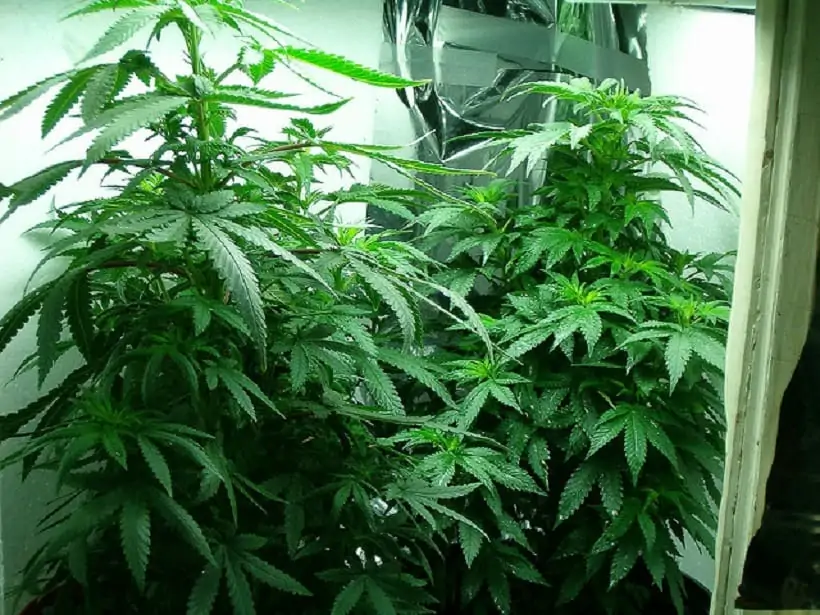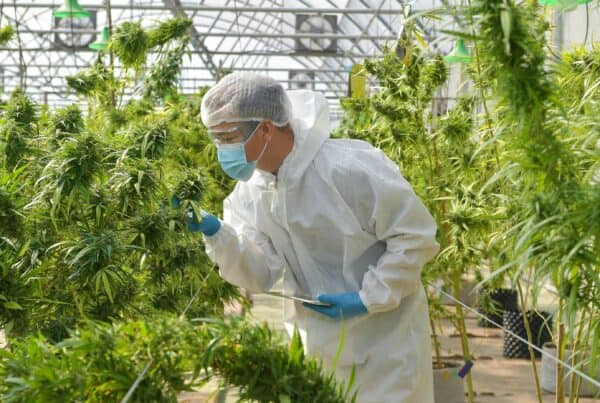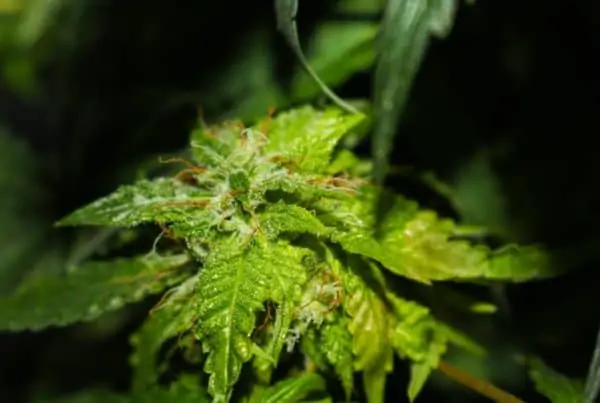TABLE OF CONTENTS
Growing cannabis at home has never been easier, but what if you are limited in space and only have a cupboard or closet to grow in?
Is it still possible to grow good weed in a small space? Our guide covers the essentials of how to grow weed in a closet.
Can I Grow Weed in a Closet?
Although it may seem like it's not a good spot to grow cannabis, a closet can be big enough to get a tiny garden started. You can also grow in a cupboard, wardrobe, or any other contained space of a similar size..
You don't even need that much closet space, but the size of your garden ultimately depends on how many plants you want to grow. You'll be fine if you're growing just one or two plants. But if you want to grow more, you may need a bigger space.
What You Need to Grow Cannabis Plants in a Closet
Growing cannabis plants in a closet is easy but requires basic cultivation equipment to keep your operation cultivation on track.
Don't worry. Growing weed doesn't have to cost an arm and a leg. You can get much of this equipment for cheap.
- Closet or small space
- Pots/container
- Grow light and hangers (LED lights are the best choice)
- Timer for grow lights
- Trays for pots and containers
- Airflow
- Cannabis seeds or clones
- Water
- Grow medium (soil)
- Carbon filter to reduce the cannabis odor
Here are a few optional things that can help you grow in a closet:
- White paint or mylar for the inside of your closet
- Small grow tent
- Hygrometer and thermometer
- pH test kit
- Screen or other supporting material for training your branches
How to Grow Weed in a Closet
An important part of getting your grow room started will be cleaning and sanitizing it.
Make sure there is no mold or excess moisture that could lead to mold.
Sanitizing your grow space and tools is essential to keeping your marijuana plants healthy.
Grow Tent
A small grow tent may fit inside your closet, but you’ll have to take measurements to see if it will accommodate your grow tent, grow lights, and other equipment. A 2’ x 2’ x 4’ grow tent can be the perfect size for an average closet grow room.
Grow Lights
The number of cannabis plants you plan to grow directly correlates with the number of lights you need. For growing cannabis in a closet, you won’t need that many grow lights. 120-140 LED watts per square foot should be enough for a 2’ x 2’ space.
We recommend LED lights since they produce less heat than other lights and have a full spectrum of light for every stage of the plant's life. In the long run, the high upfront cost can pay for itself with lower energy bills. LED lights are more energy-efficient than HID and CFL options.
A timer is an excellent tool to help you maintain a consistent light schedule for photoperiod plants. Whether you have an 18/6 vegetative schedule or a 12/12 flowering schedule, a timer can be indispensable to automating your lighting without having to manually do it.
If you don’t have a grow tent and you want better grow light exposure, consider painting the inside of the closet white or using mylar if you have permission from your landlord.
Cannabis Strain
One of the most important considerations for your closet grow room will be the strain you choose to grow. Certain strains like sativas can grow tall, especially during the flowering stage, doubling in size from their vegetative stage. Indica cannabis plants grow short and bushy for the most part.
For closet grow rooms, autoflowering strains can be a good option. These strains aren't like photoperiod strains that require a change in the light cycle. Instead, they automatically transition from the vegetative to the flowering stage after a certain period of time, regardless of the lighting situation.
In addition, you should also consider the odor of your cannabis strains since being locked up in a closet and your room can concentrate the smell. If necessary, opt for low-odor strains that still have a high cannabinoid and terpene concentration.
Growing Medium
Cannabis can be grown in various growing mediums, including soil-based or soilless systems. Setting up hydroponic systems in a small closet is not recommended. Although growing hydroponically has its pros and cons, it can create a humid environment that can lead to mold.
For best results, we recommend growing with soil, organic soil preferably, to reduce the risk of exposing your plants to contaminants. Feeding plants living organic soil is a cost-effective and healthy way to give plants the right nutrients and mimic a natural environment.
Ventilation
In such a small grow space, airflow can be difficult to achieve. Getting perfect ventilation can help you remove stale air and infuse fresh air to provide the right conditions for growth. A lack of fresh air can lead to excess humidity, mold, and plant damage.
One easy and affordable way to get airflow into the closet would be to leave the door open slightly when you turn the lights on. This can help release some of the hot air instead of letting it build up in the small space.
If possible, consider installing a couple of small oscillating fans and an exhaust fan to remove stale air and put in fresh air. Ask your landlord first because it requires making a hole in the side of the closet. You can also use a filter in the exhaust system to reduce the smell of cannabis.
If you will be including an exhaust, you should ideally put it high towards the top of the grow room since hot air rises, and place your fans at the bottom of your closet to circulate air.
Odor Control
We understand that your privacy is important. However, growing cannabis isn't a smell-proof project. Some strains smell more pungent than others. If you want it to keep your grow room a secret, odor control must be a top priority in your setup.
An exhaust ventilation system with a carbon filter can provide a measure of odor control, but you would have to also start with a low odor strain from the beginning to minimize the smell.
Watering
Since grow space is limited in a closet, you will have to water your plants by hand and be careful about under or over-watering. Ensure your pots and growing medium have the appropriate drainage and aeration to maintain a good environment. Although hand watering can get repetitive and boring, it is the best way to grow in your closet.
Plant Training Techniques
Cannabis plant training techniques can help your plant grow better with limited horizontal and vertical space. You may need to defoliate your plant if you have too many leaves that are not letting the buds on the lower branches get enough light.
Keep in mind you don't want to remove all leaves since they do provide the energy for bud production. A light pruning can help remove any yellow or discolored leaves or leaves that are entirely covering the buds.
Consider the following plant training techniques that involve either bending or breaking off branches in a closet grow to create a wider canopy:
- Low-stress training (LST)
- Topping
- Fimming
- Screen of Green (SCROG)
Learn more about plant training techniques in our 7 methods for training cannabis plants blog post.
How To Grow Weed In a Closet FAQ'S
What size closet do I need to grow weed?
For one plant, a small closet should be at least 2×2 feet. More room allows more plants or development.
How much light is needed for a closet grow?
Cannabis needs lots of light. A high-quality LED or HPS grow light that suits your closet is vital. A 200-400 watt light works well for a tiny closet.
“
There are over 300,000 jobs in the cannabis industry. CTU trained me for one of them!

Makes $24.50 @ THC +
Do I need ventilation for a closet weed grow?
Proper ventilation is essential. Install an exhaust fan to remove heated air and an oscillating fan for circulation.
What type of strain is best for a closet grow?
Compact areas like closets suit shorter, auto-flowering strains. Most indicas are shorter than sativas and therefore are better for closet growing.
How do I control the smell in a closet grow?
Add a carbon filter to your exhaust. It neutralizes odors well.
How often should I water my closet-grown weed?
Water when the top inch soil is dry. Small space cannabis growers often overwater.
Start Growing Weed in a Closet Today!
Whether you're an outdoor or indoor grower, our Master of Cannabis program can show you how to grow weed on a budget. Learn the basics and advanced techniques for growing marijuana by top growers in the industry. Enroll at CTU today!

Luis Cordova
Luis Cordova is a distinguished author, and renowned expert in cannabis cultivation, who possesses a Master's degree in Plant Biotechnology and Pharmaceutical Science. As a valued contributor to highly esteemed publications such as Cannabis Training University and Maximum Yield Magazine, Luis has emerged as a trusted source of guidance and knowledge in the cannabis industry. Having written thousands of informative articles, Luis is widely recognized for his comprehensive expertise on cultivating cannabis, both indoors and outdoors.












 Jeff was involved in an accident where he endured a traumatic brain injury. He had a week-long stay in ICU where brain surgeons
Jeff was involved in an accident where he endured a traumatic brain injury. He had a week-long stay in ICU where brain surgeons  100% risk free money back guarantee within 48 hours after purchase if student has not completed any of the courses or exams.
100% risk free money back guarantee within 48 hours after purchase if student has not completed any of the courses or exams.